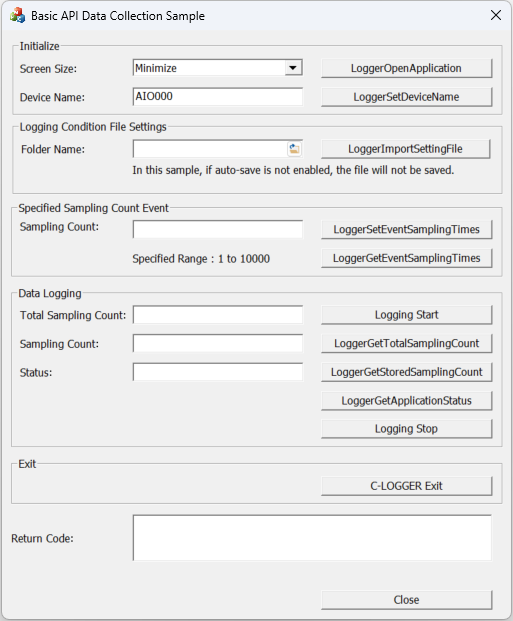

This is a sample client application that starts C-LOGGER.
This sample program starts C-LOGGER and can start and stop single-channel and multi-channel data input.
The data collected by C-LOGGER can be saved in a file on either the C-LOGGER or the client application. When collection is stopped, this sample program stores the collected data in a file ApiBasicLogger.csv on the client application.
If you want to save the data in a file on the C-LOGGER, refer "Save Acquired Data Automatically" topic.
A support
device must be installed in the Windows OS in advance.
If you do not have a support
device at hand, you can register the "AIO Demo Device" in
Windows OS to check the operation of the C-LOGGER.
For how to install the "AIO Demo Device," refer to API-TOOL(WDM)
Help "Home > Setup Driver Environment > Installing Hardware
Device > Install DEMO DEVICE ".
In addition, make device settings and channel
settings on the C-LOGGER, and confirm that data can be input from the
device.
When the device is operating normally, save the collection conditions to
a file on a local drive.
1. Initialize
- When you execute the sample program,
the main screen appears.
Specify the start size of C-LOGGER in screen. (Minimize, Normal,
Maximize)
2. Logging Condition File Setting
- Specify the acquisition conditions file saved on the C-LOGGER.
There are two ways to specify the file name of the acquisition conditions.
First, enter the file name directly in "Folder Name:" field.
Second, there is an open
folder icon to the right of "Folder Name:" field.
Clicking this open folder icon allows you to browse files in
the local drive and select a specific an acquisition conditions file.
- After specifying the acquisition
conditions file name, click the [LoggerImportSettingFile] button to load
the collection conditions file.
And then, the acquisition conditions is applied to the C-LOGGER.
3. Specified Sampling Count Event
- You can set (or get) Sampling count for the specified sampling count stored event.
4. Data Logging
- After Logging Start, the sampling is output to a file at the timing of the specified count stored event.
5. Exit
- Click [LoggerCloseApplication] button
on the main screen to terminate C-LOGGER.
You can execute the OpenApplication function from another
client application.
- To access the data on C-LOGGER, press the [LoggerOpenApplication] button again.
6. Processing to terminate the program
- Press the [Close] button in the window to terminate your client program.